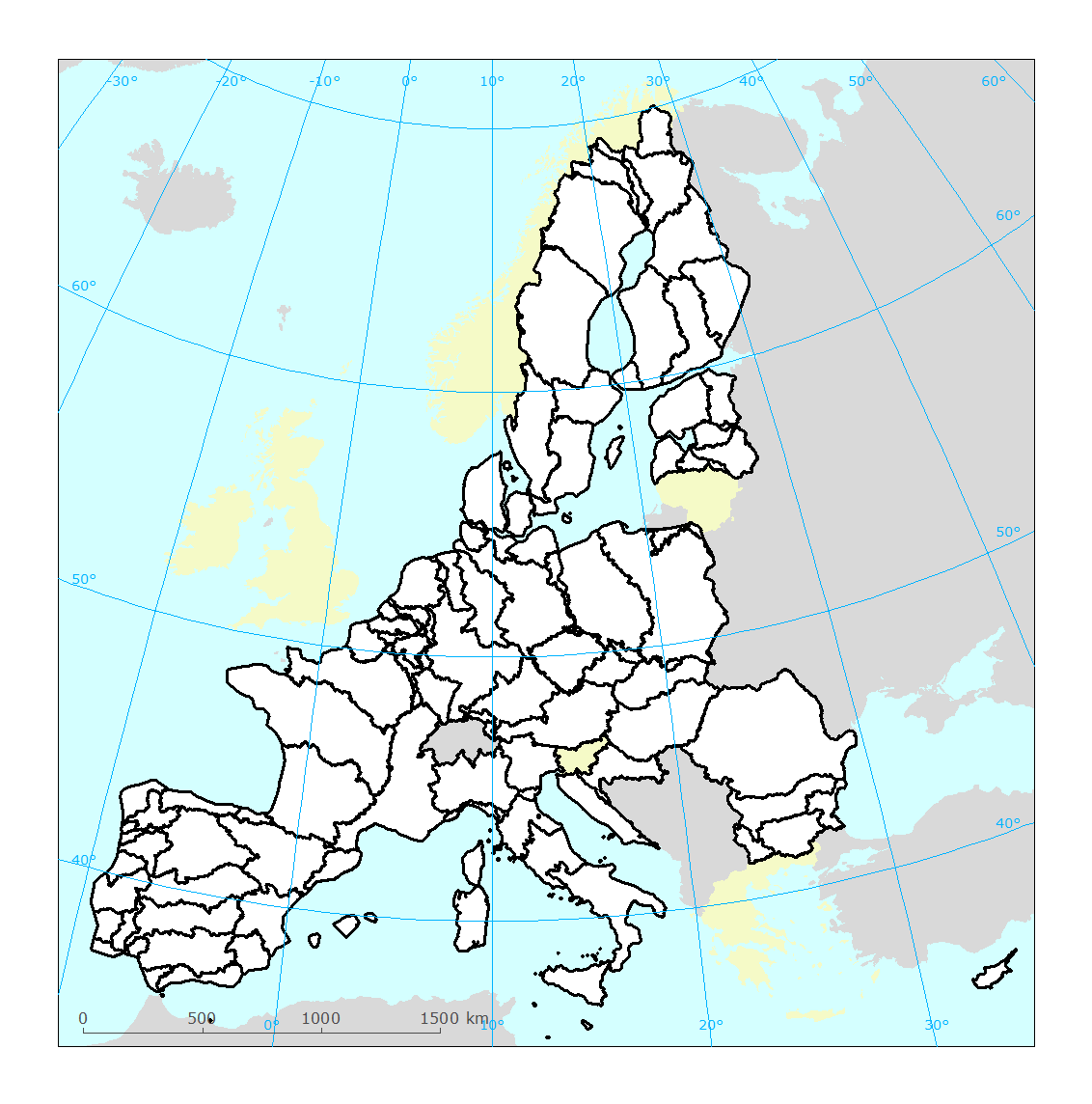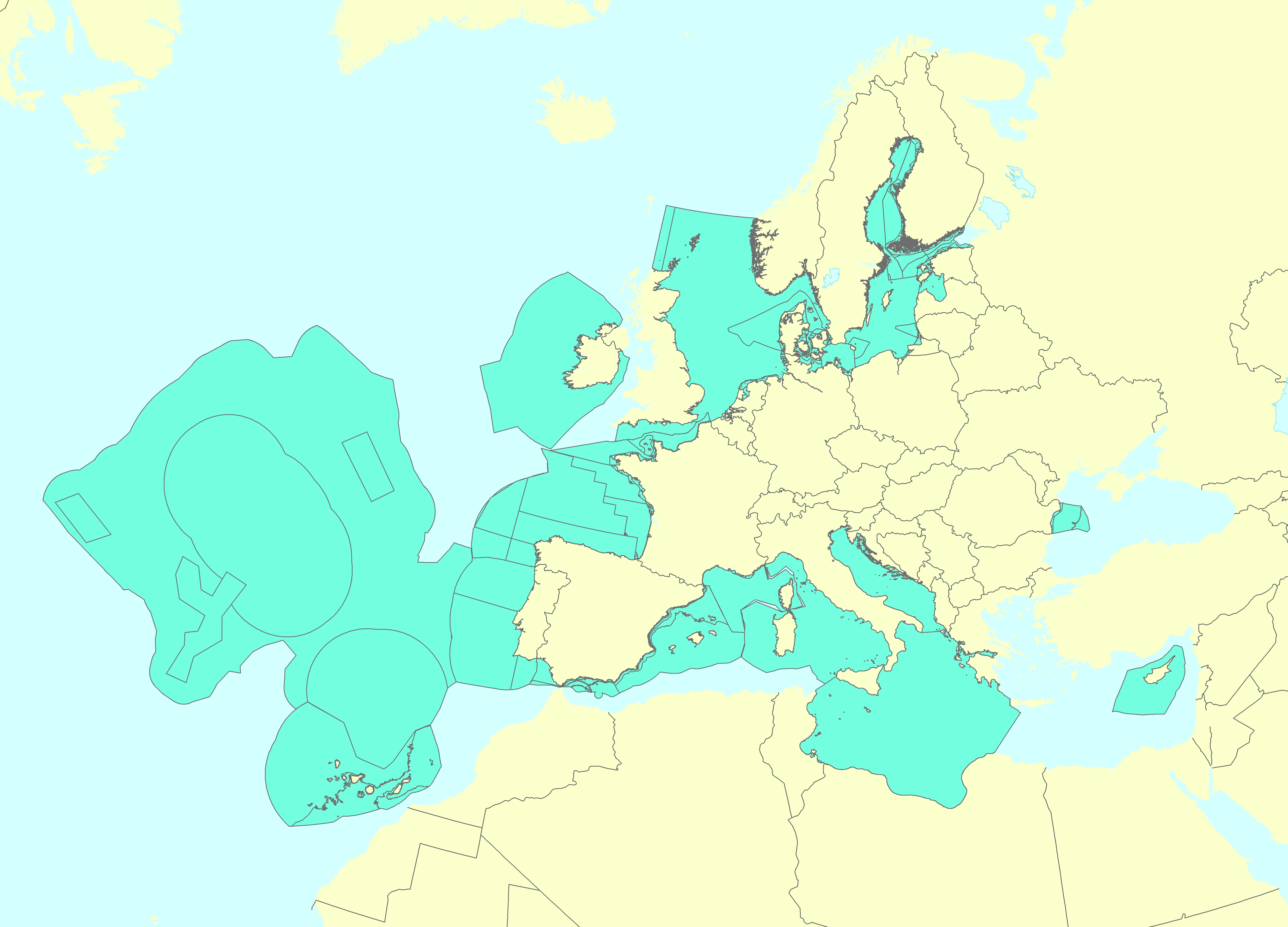Cyprus
Type of resources
Available actions
Topics
INSPIRE themes
Keywords
Contact for the resource
Provided by
Years
Formats
Representation types
Update frequencies
status
Scale
Resolution
-

The grid is based on proposal at the 1st European Workshop on Reference Grids in 2003 and later INSPIRE geographical grid systems. The sample grid available here is part of a set of three polygon grids in 1, 10 and 100 kilometres. The grids cover at least country borders and, where applicable, marine Exclusive Economic Zones v7.0, http://www.marineregions.org. Note that the extent of the grid into the marine area does not reflect the extent of the territorial waters.
-

The grid is based on proposal at the 1st European Workshop on Reference Grids in 2003 and later INSPIRE geographical grid systems. The sample grid available here is part of a set of three polygon grids in 1, 10 and 100 kilometres. The grids cover at least country borders and, where applicable, marine Exclusive Economic Zones v7.0, http://www.marineregions.org. Note that the extent of the grid into the marine area does not reflect the extent of the territorial waters.
-

The Urban Atlas is providing pan-European comparable land use and land cover data for Large Urban Zones with more than 100.000 inhabitants as defined by the Urban Audit. Urban Atlas' mission is to provide high-resolution hotspot mapping of changes in urban spaces and indicators for users such as city governments, the European Environment Agency (EEA) and European Commission departments.
-

The Common Database on Designated Areas (CDDA) is more commonly known as Nationally designated areas. The inventory began in 1995 under the CORINE programme of the European Commission. It is now one of the agreed Eionet priority data flows maintained by EEA with support from the European Topic Centre on Biological Diversity. It is a result of an annual data flow through Eionet countries. The EEA publishes the data set and makes it available to the World Database of Protected Areas (WDPA). The CDDA data can also be queried online in the European Nature Information System (EUNIS). Geographical coverage of GIS vector boundary data: Albania, Austria, Belgium, Bosnia and Herzegovina, Bulgaria, Croatia, Cyprus, Czech Republic, Denmark, Estonia, Finland, Great Britain, Greece, Ireland, France, Germany, Iceland, Italy, Kosovo under UNSC Resolution 1244/99, Latvia, Liechtenstein, Lithuania, the North Macedonia, the Netherlands, Norway, Poland, Portugal, Romania, Serbia, Slovakia, Slovenia, Spain, Sweden and Switzerland. EEA does not have permission to distribute some or all sites reported by Austria, Estonia, Hungary, Ireland, Kosovo under UNSC Resolution 1244/99, Malta, the Netherlands, Romania, Slovenia and Turkey. Copyright is to be mentioned for Estonia: "Estonian Environmental Register 18.02.2013. On-line resource linkage: www.keskkonnainfo.ee"; and for Finland: "©Finnish Environment Institute, 2012".
-

The Common Database on Designated Areas (CDDA) is more commonly known as Nationally designated areas. The inventory began in 1995 under the CORINE programme of the European Commission. It is now one of the agreed Eionet priority data flows maintained by EEA with support from the European Topic Centre on Biological Diversity. It is a result of an annual data flow through Eionet countries. The EEA publishes the data set and makes it available to the World Database of Protected Areas (WDPA). The CDDA data can also be queried online in the European Nature Information System (EUNIS). Geographical coverage of GIS vector boundary data: Albania, Austria, Belgium, Bosnia and Herzegovina, Bulgaria, Croatia, Cyprus, Czech Republic, Denmark, Estonia, Finland, Great Britain, Greece, Ireland, France, Germany, Iceland, Italy, Kosovo under UNSC Resolution 1244/99, Latvia, Liechtenstein, Lithuania, the North Macedonia, the Netherlands, Norway, Poland, Portugal, Romania, Serbia, Slovakia, Slovenia, Spain, Sweden and Switzerland. EEA does not have permission to distribute some or all sites reported by Austria, Estonia, Hungary, Ireland, Kosovo under UNSC Resolution 1244/99, Malta, the Netherlands, Romania, Slovenia and Turkey. Copyright is to be mentioned for Estonia: "Estonian Environmental Register 18.02.2013. On-line resource linkage: www.keskkonnainfo.ee"; and for Finland: "©Finnish Environment Institute, 2012".
-

CORINE Land Cover (CLC) was specified to standardize data collection on land in Europe to support environmental policy development. The reference year of first CLC inventory was 1990 (CLC1990), and the first update created in 2000. Later the update cycle has become 6 years. The number of participating countries has increased over time − currently includes 33 European Environment Agency (EEA) member countries and six cooperating countries (EEA39) with a total area of over 5.8 Mkm2. Ortho-corrected high spatial resolution satellite images provide the geometrical and thematic basis for mapping. In-situ data (topographic maps, ortho-photos and ground survey data) are essential ancillary information. The project is coordinated by the EEA in the frame of the EU Copernicus programme and implemented by national teams under the management and quality control (QC) of the EEA. The basic technical parameters of CLC (i.e. 44 classes in nomenclature, 25 hectares minimum mapping unit (MMU) and 100 meters minimum mapping width) have not changed since the beginning, therefore the results of the different inventories are comparable. The layer of CORINE Land Cover Changes (CLCC) is produced since the second CLC inventory (CLC2000). CLCC is derived from satellite imagery by direct mapping of changes taken place between two consecutive inventories, based on image-to-image comparison. Change mapping applies a 5 ha MMU to pick up more details in CLCC layer than in CLC status layer. Integration of national CLC and CLCC data includes some harmonization along national borders. Two European validation studies have shown that the achieved thematic accuracy is above the specified minimum (85 %). Primary CLC and CLCC data are in vector format with polygon topology. Derived products in raster format are also available. The seamless European CLC and CLCC time series data (CLC1990, CLC2000, CLC2006, CLC2012 and related CLCC data) are distributed in the standard European Coordinate Reference System defined by the European Terrestrial Reference System 1989 (ETRS89) datum and Lambert Azimuthal Equal Area (LAEA) projection (EPSG: 3035). Results of the CLC inventories can be downloaded from Copernicus Land site free of charge for all users. CLC data can contribute to a wide range of studies with European coverage, e.g.: ecosystem mapping, modelling the impacts of climate change, landscape fragmentation by roads, abandonment of farm land and major structural changes in agriculture, urban sprawl, water management.
-

The dataset contains information on the European river basin districts delineated for the 1st River Basin Management Plans (RBMP) under the Water Framework Directive (WFD). The information was reported to the European Commission under the Water Framework Directive (WFD) reporting obligations. The dataset compiles the available spatial data related to the 1st RBMPs which were due in 2010 (hereafter WFD2010). See http://rod.eionet.europa.eu/obligations/521 for further information on the WFD2010 reporting. It was prepared to support the reporting of the 2nd RBMPs due in 2016 (hereafter WFD2016). See http://rod.eionet.europa.eu/obligations/715 for further information on the WFD2016 reporting. The data reported in WFD2010 were updated using data reported in WFD2016, whenever the spatial objects are identical in 2010 and 2016. For WFD2010 objects, some information may be missing, if the objects no longer exist in the 2nd River Basin Management Plans, and were not reported in WFD2016. This dataset updates the information published in "WISE River basin districts (RBD) - version 1.4, Jun. 2011" (http://sdi.eea.europa.eu/catalogue/srv/eng/catalog.search#/metadata/3be396a5-dded-4492-a620-f42d9f4aba5c) Relevant concepts: River basin district: The area of land and sea, made up of one or more neighbouring river basins together with their associated groundwaters and coastal waters, which is the main unit for management of river basins. River basin: The area of land from which all surface run-off flows through a sequence of streams, rivers and, possibly, lakes into the sea at a single river mouth, estuary or delta.
-

The dataset contains information on the European groundwater bodies delineated for the 2nd River Basin Management Plans (RBMP) under the Water Framework Directive (WFD). The information was reported to the European Commission under the Water Framework Directive (WFD) reporting obligations. The dataset compiles the available spatial data related to the 2nd RBMPs due in 2016 (hereafter WFD2016). See http://rod.eionet.europa.eu/obligations/715 for further information on the WFD2016 reporting. Relevant concepts: Groundwater body: 'Body of groundwater' means a distinct volume of groundwater within an aquifer or aquifers. Groundwater: All water which is below the surface of the ground in the saturation zone and in direct contact with the ground or subsoil. Aquifer: Subsurface layer or layers of rock or other geological strata of sufficient porosity and permeability to allow either a significant flow of groundwater or the abstraction of significant quantities of groundwater.
-

The dataset contains information on the European river basin districts delineated for the 2nd River Basin Management Plans (RBMP) under the Water Framework Directive (WFD). The information was reported to the European Commission under the Water Framework Directive (WFD) reporting obligations. The dataset compiles the available spatial data related to the 2nd RBMPs due in 2016 (hereafter WFD2016). See http://rod.eionet.europa.eu/obligations/715 for further information on the WFD2016 reporting. Relevant concepts: River basin district: The area of land and sea, made up of one or more neighbouring river basins together with their associated groundwaters and coastal waters, which is the main unit for management of river basins. River basin: The area of land from which all surface run-off flows through a sequence of streams, rivers and, possibly, lakes into the sea at a single river mouth, estuary or delta.
-

The Marine Reporting Units (MRUs) are used within the reporting obligations of the Marine Strategy Framework Directive (MSFD) in order to link the implementation of the different articles to specific marine areas. The MRUs can be of varying sizes, according to the appropriate scale for the different reports (e.g. region, sub-region, regional or sub-regional subdivision, Member State marine waters, WFD coastal waters, etc.), as indicated in the Good Environmental Status 2017 Decision. The present data set is the second public version released of the MRUs used during the MSFD 2018 reporting exercise on the update of Articles 8, 9 and 10. Only the MRUs of those countries that have gone through the reporting exercise by June 2020 have been included in this data set. Apart from the countries included already in version 1 of the dataset (SE, FI, EE, LV, PL, DE, DK, NL, BE, FR, ES, HR and RO), this version also includes seven more countries, namely MT, LT, IT, SI, CY, PT and IE. The data set is distributed in SHP and in INSPIRE-compliant GML format, made available also through an INSPIRE compliant ATOM service.
 RUC Geo-Data catalogue
RUC Geo-Data catalogue